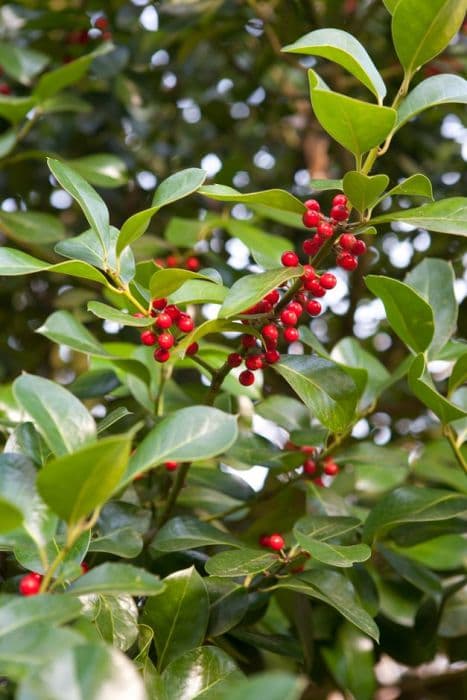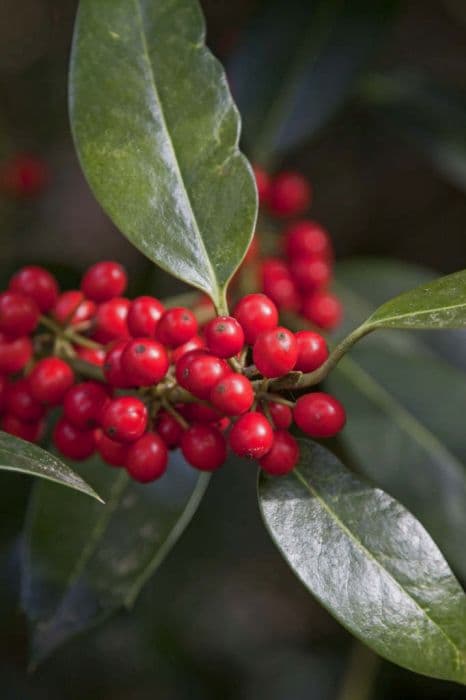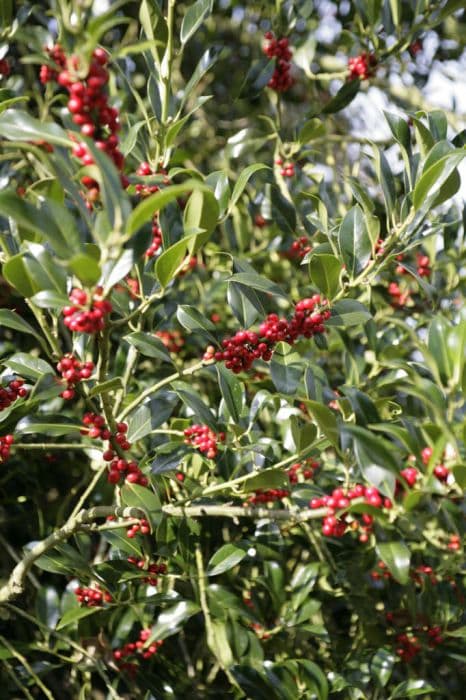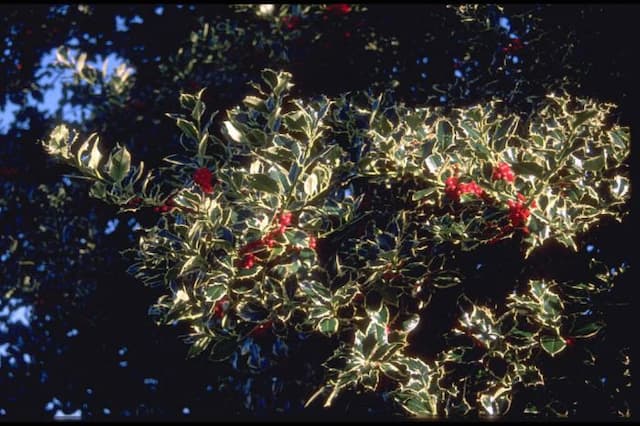Highclere Holly Ilex × altaclerensis 'Wilsonii' (f)

ABOUT
Ilex × altaclerensis 'Wilsonii', often referred to as Highclere holly, is a striking evergreen plant that showcases a dense, bushy growth habit. It is known for its shiny, dark green leaves which have a unique shape; unlike typical holly leaves, they do not have spines along the edges but are instead smooth with a slightly undulated margin, giving it a more refined appearance compared to other hollies. In the colder months, Highclere holly becomes particularly attractive due to its prolific display of vivid red berries, which contrast spectacularly with the glossy foliage. These berries are especially popular amongst birds who seek them out for food during winter when resources are scarce. The foliage serves as an excellent backdrop in garden settings, adding a deep green, lush texture throughout the year. Highclere holly flowers are less noticeable compared to its leaves and berries, but they do provide a subtle charm when they emerge, typically being small and white. This holly variety is quite versatile and can be used in various landscape applications, including hedges, screens, or as a standalone specimen, offering year-round interest and an elegant structural presence in the garden—minus the spines commonly associated with holly leaves. Its adaptability and attractive features make it a beloved choice for gardeners looking to add a touch of elegance and vibrant color to their outdoor spaces.
About this plant
 Names
NamesFamily
Aquifoliaceae.
Synonyms
Highclere Holly, Wilson's Holly.
Common names
Ilex × altaclerensis 'Wilsonii' (f).
 Toxicity
ToxicityTo humans
The Highclere holly is considered to be mildly toxic to humans if ingested. The berries especially contain certain alkaloids such as theobromine and saponins, along with other potentially toxic compounds. Eating the berries can cause symptoms like nausea, vomiting, diarrhea, and abdominal pain. In rare cases or if consumed in large amounts, more severe symptoms could potentially develop, such as drowsiness, seizures, or difficulty breathing. It is important to avoid eating any part of the Highclere holly, as it is not considered safe for human consumption.
To pets
The Highclere holly is also toxic to pets, including dogs and cats. Its berries contain compounds like theobromine and saponins, which can cause gastrointestinal upset in pets. Symptoms of poisoning in pets might include vomiting, diarrhea, decreased appetite, drooling, or lethargy. Depending on the amount ingested, more serious symptoms can occur, such as heart arrhythmias or neurological symptoms. It is crucial to prevent pets from ingesting any part of the plant to avoid these toxic effects. If you suspect your pet has eaten Highclere holly, consult a veterinarian immediately.
 Characteristics
CharacteristicsLife cycle
Perennials
Foliage type
Evergreen
Color of leaves
Green
Flower color
White
Height
8-10 feet (2.4-3 meters)
Spread
8-10 feet (2.4-3 meters)
Plant type
Shrub
Hardiness zones
6-9
Native area
Cultivar
Benefits
 General Benefits
General Benefits- Visual Appeal: 'Wilsonii', a cultivar of Highclere holly, has lustrous, dark green foliage and a dense, pyramidal shape, adding aesthetic value to landscapes.
- Winter Interest: Produces bright red berries that persist through winter, providing color during the drab months.
- Wildlife Habitat: Offers shelter and food for birds and other wildlife, particularly in winter when other sources are scarce.
- Privacy Screen: Can be used as a hedge or screen, providing privacy and reducing noise when planted in rows.
- Drought Tolerance: Once established, it has good resistance to drought, minimizing the need for watering.
- Low Maintenance: Requires relatively little care once established, with infrequent pruning to shape or maintain size.
- Tolerates Salt: Can be planted in coastal areas as it has some tolerance to salt spray.
- Adaptable: Adapts well to a range of soil types, though it prefers well-drained, slightly acidic soil.
 Medical Properties
Medical PropertiesThis plant is not used for medical purposes.
 Air-purifying Qualities
Air-purifying QualitiesThis plant is not specifically known for air purifying qualities.
 Other Uses
Other Uses- Hedging and Topiary: Highclare Holly can be pruned into beautiful hedge formations or shaped into various topiary designs, often serving as an eye-catching element in formal gardens.
- Privacy Screen: Due to its dense foliage, this plant is often used to create privacy screens in gardens and between properties.
- Bird Habitat: The dense branches and foliage provide excellent shelter for birds, making it a good choice for attracting wildlife to the garden.
- Winter Garden Interest: The dark green, glossy leaves of Highclare Holly add color and texture to gardens in the winter months when many other plants have died back or lost their leaves.
- Coastal Gardening: Highclare Holly is suitable for coastal areas, as it can tolerate salt spray and wind, making it a practical choice for seaside landscapes.
- Bonsai: This variety of holly can also be grown as a bonsai, with its small leaves and berries being particularly attractive features when miniaturized.
- Cultural Symbolism: In some cultures, holly is a symbol of goodwill and joy, and thus the plant can be incorporated into gardens for its symbolic value, especially around the holiday season.
- Festive Decorations: Branches of Highclare Holly may be cut and used as part of festive decorations, wreaths, and table arrangements during the winter holidays.
- Erosion Control: Its root system helps to prevent soil erosion, making it a functional planting choice on slopes and areas with loose soil.
- Photography Backdrop: The robust and vibrant foliage of Highclare Holly provides a lush green background for outdoor portrait photography.
Interesting Facts
 Feng Shui
Feng ShuiThe Highclere holly is not used in Feng Shui practice.
 Zodiac Sign Compitability
Zodiac Sign CompitabilityThe Highclere holly is not used in astrology practice.
 Plant Symbolism
Plant Symbolism- Protection: Ilex, commonly known as holly, has been associated with protection since ancient times. It was believed to guard against evil spirits and negative energy.
- Good Fortune: Holly is often connected with good luck and is used during the winter holidays to invite positive energy into the home.
- Fertility: With its robust growth and evergreen nature, holly symbolizes fertility and life, representing the continual renewal of life.
- Hope: The evergreen leaves of holly represent hope and the promise that the sun will return after the dark winter months.
 Water
WaterThe Highclere holly should be watered thoroughly, ensuring that the soil is moist but not waterlogged. During the first growing season, it's crucial to establish a good root system, which means watering the plant deeply once or twice a week depending on weather conditions. Once established, they are more drought-tolerant and typically require less frequent watering. However, during prolonged periods of dryness or extreme heat, additional watering may be necessary, totaling about 1 to 2 gallons per week. Always make sure the top inch of soil is dry before watering again to prevent overwatering.
 Light
LightHighclere holly thrives in full sun to partial shade. The ideal spot for this plant is an area where it can receive at least 4 to 6 hours of direct sunlight daily. These light conditions ensure vibrant foliage and optimal growth. However, it can also tolerate less intense light, making it versatile for different garden settings.
 Temperature
TemperatureHighclere holly prefers a temperate climate with temperatures ranging from around 50°F to 70°F for optimal growth. It can withstand minimum winter temperatures down to 20°F but can be damaged by severe cold below this range. During hot summer months, ensure that it doesn’t get too stressed by heat, especially if temperatures rise above 90°F.
 Pruning
PruningHighclere holly should be pruned to maintain shape and promote vigorous growth. The best time to prune is in late winter or early spring before new growth begins. It can also be pruned in mid-summer if light shaping is needed. Overly vigorous or crossing branches can be removed, as well as any damaged or diseased wood. Regular annual pruning will help to keep the plant looking tidy and may encourage more prolific berry production.
 Cleaning
CleaningAs needed
 Soil
SoilHighclere holly prefers well-draining, acidic to neutral soil with a pH between 5.5 and 7.0. Use a mix of peat, garden soil, and perlite or sand for improved aeration and drainage.
 Repotting
RepottingHighclere holly should be repotted every 2-3 years. Young plants may need repotting more often, while mature plants can be repotted less frequently.
 Humidity & Misting
Humidity & MistingHighclere holly is adaptable but prefers moderate humidity levels. It thrives best in an environment with humidity levels between 40% and 60%.
 Suitable locations
Suitable locationsIndoor
Provide bright indirect light, keep soil moist, and maintain moderate humidity.
Outdoor
Plant in partial shade, mulch well, and protect from strong winds.
Hardiness zone
6-9 USDA
 Life cycle
Life cycleIlex × altaclerensis 'Wilsonii', commonly known as Highclere holly, begins its life as a seed, which upon germination produces a small seedling. The seedling grows into a juvenile plant, establishing roots and a stem, and then develops into a mature shrub with a robust root system and evergreen foliage. During its reproductive stage, the mature Highclere holly produces small white flowers, which, because 'Wilsonii' is a female clone, have the potential to be pollinated by nearby male hollies. Once pollinated, the flowers develop into bright red berries, a characteristic feature of this plant, which persist through winter and are attractive to birds and other wildlife. Eventually, as the plant ages, it enters a decline phase, where growth slows and it may become susceptible to environmental stresses or diseases. Even at the end of its life, a Highclere holly can contribute to the ecosystem through its decomposing organic matter, thereby closing the life cycle loop.
 Propogation
PropogationPropogation time
Early Spring
The highclere holly, known scientifically as Ilex × altaclerensis 'Wilsonii' (f), is most commonly propagated by semi-hardwood cuttings. This method is typically done in late summer, when the current season's growth has started to mature and harden slightly. A cutting of about 6 to 8 inches (15 to 20 centimeters) is snipped from a healthy branch. The leaves from the lower half of the stem are removed, and the cut end can be dipped in a rooting hormone to encourage root development. The stem is then planted in a well-draining potting mix, ensuring the remaining leaves are not buried. The pot is kept under high humidity conditions, such as under a plastic cover, and in indirect light until roots have formed, which can take several weeks to a few months. Once rooted, the new plant can be gradually acclimated to less humid conditions and eventually transplanted outdoors.









